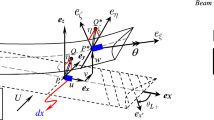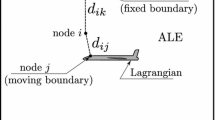Abstract
The control of coupled flexural–torsional oscillations of a composite wing by means of monoclinic structures in a reinforced plating is considered. Decomposition of the potential energy of deformation and kinetic energy of natural oscillation modes into coupled and uncoupled parts allows us to introduce two coefficients (as measures of the coupling of oscillation modes) that integrally consider the effect of the geometry and reinforcement structure on the dynamic-response parameters of the wing. These coefficients describe the elastic and inertial coupling of the natural oscillation modes, respectively. Numerical studies are performed to assess the effect of the orientation of considerably anisotropic carbon-fiber-reinforced plastic (CFRP) layers in the plating on natural frequencies, loss factors, and coefficients of elastic and inertial coupling for several lower tones of natural flexural–torsional oscillations of the wing. Combined analysis of the results obtained shows that, for each pair of flexural–torsional oscillation modes, there are orientation-angle ranges of the reinforcing layers where the inertial coupling caused by asymmetry of the cross-sectional profile with respect to the major axes of inertia decreases right down to complete extinction due to the generation of elastic coupling in the plating material. These ranges are characterized by two main features: (i) the difference in the natural frequencies of the pair of flexural–torsional oscillation modes is minimal and (ii) the natural frequencies of flexural–torsional oscillations belong to a segment restricted by corresponding partial natural frequencies of the pair of oscillation modes.





Similar content being viewed by others
REFERENCES
S. Daynes and P. M. Weaver, “Stiffness tailoring using prestress in adaptive composite structures,” Compos. Struct. 106, 282–287 (2013).
M. M. Munk, “Propeller containing diagonally disposed fibrous material,” US Patent No. 2484308 A (1949).
M. M. Munk, “Laminated propeller,” US Patent No. 2599718 A (1952).
R. M. Jones, Mechanics of Composite Materials, 2nd ed. (Taylor, Boca Raton, Fla., 1999).
K. Hayat, A. G. M. de Lecea, C. D. Moriones, and S. K. Ha, “Flutter performance of bend-twist coupled large-scale wind turbine blades,” J. Sound Vib. 370, 149–162 (2016).
L. Wang, A. Kolios, T. Nishino, P.-L. Delafin, and T. Bird, “Structural optimisation of vertical-axis wind turbine composite blades based on finite element analysis and genetic algorithm,” Compos. Struct. 153, 123–138 (2016).
M. R. Motley and R. B. Barber, “Passive control of marine hydrokinetic turbine blades,” Compos. Struct. 110, 133–139 (2014).
W. Li, H. Zhou, H. Liu, Y. Lin, and Q. Xu, “Review on the blade design technologies of tidal current turbine,” Renewable Sustainable Energy Rev. 63, 414–422 (2016).
A. Azzam and W. Li, “Theoretical and experimental methods on bend-twist coupling and damping properties with the relationship to lay-up of the composite propeller marine: A review,” Int. J. Eng. Science Technol. 4, 2907–2917 (2012).
Y. L. Young, “Dynamic hydroelastic scaling of self-adaptive composite marine rotors,” Compos. Struct. 92, 97–106 (2010).
O. A. Bauchau, B. S. Coffenberry, and L. W. Rehfield, “Composite box beam analysis: Theory and experiments,” J. Reinf. Plast. Compos. 6, 25–35 (1987).
C. Libove, “Stresses and rate of twist in single-cell thin-walled beams with anisotropic walls,” AIAA J. 26, 1107–1118 (1988).
O. A. Bauchau and C. H. Hong, “Nonlinear composite beam theory,” J. Appl. Mech. 55, 156–163 (1988).
L. W. Rehfield and A. R. Atilgan, “Shear center and elastic axis and their usefulness for composite thin-walled beams,” in Proceedings American Society for Composites 4th Tech. Conf., Blacksburg, Va., 1989, pp. 179–188.
J. Altenbach, H. Altenbach, and V. Matzdorf, “A generalized Vlasov theory for thin-walled composite beam structures,” Mech. Compos. Mater. 30, 57–71 (1994).
W. K. Lentz, E. A. Armanios, and A. M. Badir, “Constrained optimization of thin-walled composite beams with coupling,” in Proc. AIAA/ASME/ASCE/AHS/ASC 37th Structures, Structural Dynamics and Materials Conf., April 15–17, 1996 (American Inst. of Aeronautics and Astronautics, Reston, Va, 1996), Part 4, pp. 2326–2334.
M. Mitra, S. Gopalakrishnan, and M. S. Bhat, “A new convergent thin walled composite beam element for analysis of box beam structures,” Int. J. Solids Struct. 41, 1491–1518 (2004),
W. Yu, L. Liao, D. H. Hodges, and V. V. Volovoi, “Theory of initially twisted, composite, thin-walled beams,” Thin-Walled Struct. 43, 1296–1311 (2005).
L. Shan and P. Qiao, “Flexural-torsional buckling of fiber-reinforced plastic composite open channel beams,” Compos. Struct. 68, 211–224 (2005).
R. E. Murray, D. A. Doman, and M. J. Pegg, “Finite element modeling and effects of material uncertainties in a composite laminate with bend-twist coupling,” Compos. Struct. 121, 362–376 (2015).
L. Librescu and O. Song, Thin-Walled Composite Beams. Theory and Application (Springer-Verlag, Dordrecht, 2006).
L. C. Bank and C. H. Kao, “The influence of geometric and material design variables on the free vibration of thin-walled composite material beams,” J. Vib., Acoust., Stress Reliab. Des. 111, 290–297 (1989).
K. N. Koo and I. Lee, “Aeroelastic behavior of a composite plate wing with structural damping,” Comput. Struct. 50, 167–176 (1994).
E. A. Armanios and A. M. Badir, “Free vibration analysis of anisotropic thin-walled closed-section beams,” AIAA J. 33, 1905–1910 (1995).
L. R. Centolanza, E. C. Smith, and B. Kumar, “Refined structural modeling and structural dynamics of elastically tailored composite rotor blades,” in Proc. AIAA/ASME/ASCE/AHS/ASC 37th Structures, Structural Dynamics and Materials Conf., April 15–17, 1996 (American Inst. of Aeronautics and Astronautics, Reston, Va, 1996), Part 4, pp. 2002–2012.
Z. Qin and L. Librescu, “Aeroelastic instability of aircraft wings modelled as anisotropic composite thin-walled beams in incompressible flow,” J. Fluids Struct. 18, 43–61 (2003).
S.-Y. Oh, O. Song, and L. Librescu, “Effects of pretwist and presetting on coupled bending vibrations of rotating thin-walled composite beams,” Int. J. Solids Struct. 40, 1203–1224 (2003).
M. Kameyama and H. Fukunaga, “Optimum design of composite plate wings for aeroelastic characteristics using lamination parameters,” Comput. Struct. 85, 213–224 (2007).
M. T. Piovan, C. P. Filipich, and V. H. Cortinez, “Exact solutions for coupled free vibrations of tapered shear-flexible thin-walled composite beams,” J. Sound Vib. 316, 298–316 (2008).
C. Santiuste, S. Sanchez-Saez, and E. Barbero, “Dynamic analysis of bending-torsion coupled composite beams using the flexibility influence function method,” Int. J. Mech. Sci. 50, 1611–1618 (2008).
T. P. Vo, J. Lee, and N. Ahn, “On sixfold coupled vibrations of thin-walled composite box beams,” Compos. Struct. 89, 524–535 (2009).
S. H. Mirtalaie and M. A. Hajabasi, “Study of coupled lateral-torsion free vibrations of laminated composite beam: analytical approach,” World Acad. Sci., Eng. Tech. 54, 699–704 (2011).
S. H. Mirtalaie, M. Mohammadi, M. A. Hajabasi, and F. Hejripour, “Coupled lateral-torsion free vibrations analysis of laminated composite beam using differential quadrature method,” World Acad. Sci., Eng. Technol. 67, 117–122 (2012).
V. M. Ryabov and B. A. Yartsev, “Coupled damping vibrations of composite structures,” Vestn. St. Petersburg Univ.: Math. 45, 168–173 (2012).
M. R. Motley, M. R. Kramer, and Y. L. Young, “Free surface and solid boundary effects on the free vibration of cantilevered composite plates,” Compos. Struct. 96, 365–375 (2013).
S. A. Sina and H. Haddadpour, “Axial-torsional vibrations of rotating pretwisted thin walled composite beams,” Int. J. Mech. Sci. 80, 93–101 (2014).
N. I. Kim and J. Lee, “Divergence and flutter behavior of Beck’s type of laminated box beams,” Int. J. Mech. Sci. 84, 91–101 (2014).
A. Szekrényes, “Coupled flexural-longitudinal vibration of delaminated composite beams with local stability analysis,” J. Sound Vib. 333, 5141–5164 (2014).
A. S. Sayyad and Y. M. Ghugal, “On the free vibration analysis of laminated composite and sandwich plates: A review of recent literature with some numerical results,” Compos. Struct. 129, 177–201 (2015).
V. M. Ryabov and B. A. Yartsev, “Natural damped vibrations of anisotropic box beams of polymer composite materials: 1. Statement of the problem,” Vestn. St. Petersburg Univ.: Math. 49, 130–137 (2016). https://doi.org/10.3103/S1063454116020126
V. M. Ryabov and B. A. Yartsev, “Natural damped vibrations of anisotropic box beams of polymer composite materials. 2. Numerical experiments,” Vestn. St. Petersburg Univ.: Math. 49, 260–268 (2016). https://doi.org/10.3103/S1063454116030110
V. M. Ryabov and B. A. Yartsev, “Nonclassical vibrations of a monoclinic composite strip,” Vestn. St. Petersburg Univ.: Math. 54, 437–446 (2021). https://doi.org/10.1134/S1063454121040166
Y. C. Fung, An Introduction to the Theory of Aeroelasticity (Wiley, New York, 1955; Fizmatlit, Moscow, 1959).
K. Washizu, Variational Methods in Elasticity and Plasticity (Pergamon, Oxford, 1982; Mir, Moscow, 1987).
W. Voigt, Lehrbuch der Kristallphysik (Teubner, Leipzig, 1928).
Author information
Authors and Affiliations
Corresponding authors
Ethics declarations
The authors declare that they have no conflicts of interest.
Additional information
Translated by V. Arutyunyan
About this article
Cite this article
Ryabov, V.M., Yartsev, B.A. Control of Composite-Wing Oscillation Coupling. Vestnik St.Petersb. Univ.Math. 56, 252–260 (2023). https://doi.org/10.1134/S1063454123020152
Received:
Revised:
Accepted:
Published:
Issue Date:
DOI: https://doi.org/10.1134/S1063454123020152




